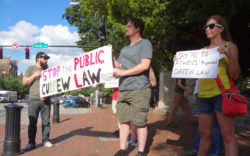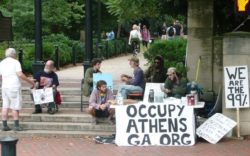Athens’ Bicycle and Pedestrian Master Plan (now dubbed Athens in Motion) is moving toward completion—on paper, that is. Sidewalks, bike lanes and multi-use, off-road paths are not cheap to build, and costs are rising, so it could take decades to build out the template that the plan is intended to provide. But because Athens voters approved a new 1 percent transportation sales tax earlier this year, significant money will be available to begin building more and better-connected sidewalks and bikeways.
The evolving plan, managed by consultant Toole Design Group and abetted by a very active committee of citizens chaired by Ken Sherman, crunched data along with considerable citizen input to produce a prioritized map of bike routes and additional sidewalks. Routes to schools got higher ranking; costly ones a lower one. The map designates mostly intown and Eastside streets where the most people live and travel as potential bike routes—less-congested secondary streets like Dougherty, Hancock, Barber and Chase, plus Milledge, Broad and other roads farther out—but it does not specify what treatment each street will get. On-street bike lanes could be added, or off-road paths, which seem to be an increasingly popular choice.
The plan will not put to rest contentious political conflicts, like changes to Prince Avenue. Safer biking along Prince was a most-requested item by citizens, and both Prince and parallel but less convenient Boulevard are shown as bike routes. Not many communities have as much citizen interest in bike issues as Athens, said Toole’s Jared Draper.
In making their recommendations, the consultants considered the “comfort level” of possible projects, aiming to attract more users and not just increase the lane-miles of facilities. While some bicyclists are “fearless,” the consultants said, many more are “interested but concerned” about their safety—especially about sharing roads with cars. What projects are actually built will be decided, eventually, by Athens-Clarke County commissioners.
Over 50 citizens attended a public drop-in event last week to see and ask questions about the plan. “I ride my bike to work every day,” local business owner Mike Bradshaw told Flagpole. But bikeways have not been a priority in Athens, he said, asking, “Why can’t my kids ride their bikes to school?” Bradshaw would prefer multi-use paths instead of on-street bike lanes—“I would love for us to get around without having to hit the streets,” he said—and is “super excited” about the new sales tax funds for bike facilities.
But to some, funding bike and greenway trail projects with a sales tax is an unjustified burden on poor Athenians to pay for middle-class luxuries; others argue that it is just such amenities that attract new businesses and jobs to Athens. And far more of the penny sales tax will go to buses, road maintenance, sidewalks and street improvements (which may also include separated bike lanes) than specifically to bike projects. [John Huie]
Bike Lanes Proposed for Barber, Barnett Shoals
County staff and commissioners are already looking at adding bike infrastructure to Chase Street and Barnett Shoals Road. The Transportation and Public Works Department, along with Toole Design Group, gave presentations on those corridors at a June 12 work session.
Chase Street has already been through a number of changes in the past year. In 2016, TPW recommended removing two travel lanes from Chase north of the Loop. That change proved unpopular, as business owners complained that their trucks were stuck in traffic, so it was quickly reversed. There’s currently no bike connectivity to the industrial area north of Boulevard, where the Chase Park warehouses are thriving and more mixed-use developments in former factories like Southern Mill and Westclox are in the works.
Residents on Chase want to keep their turn lane because fast-moving traffic makes it hard to turn into and out of their homes, but with the center lane there’s no room for bike lanes, which presented a dilemma for officials. “It was a challenging time for a lot of reasons, but we came through it,” TPW Director Drew Raessler said.
After gathering more public input, the proposed solution is to route bike traffic along Barber Street, where there is enough room in the right-of-way to add a multi-use path between Boulevard and Newton Bridge Road. Another shared-use path would connect Barber to Chase via Oneta Street, and wide Boulevard would get bike lanes buffered from on-street parking by three feet of paint to protect cyclists from car doors.
Three roundabouts—at both Loop interchanges and Oneta Street, all designed to accommodate semi trucks—would be built on Chase, and lanes would be narrowed at the bridge over the railroad. Not only would those changes slow traffic, but the roundabouts would reduce wait times to get on and off the Loop, Draper said. The unsignalized inner-Loop interchange, currently rated as “failing,” would improve to a B grade during the morning rush hour and an A in the afternoon, according to a traffic analysis.
Commissioner (and Mayor-elect) Kelly Girtz said he’s in favor of the changes, given that a new bridge wide enough for bike lanes likely isn’t in the works anytime soon. But Commissioner Melissa Link said she still wants to see bike infrastructure on Chase, arguing that cyclists in Normaltown won’t go out of their way to Barber.
When car speeds are lower, bikes may be able to safely share the road, Raessler said, or residents south of the bridge might be willing to give up the turn lane once they see that traffic has slowed. “They’re in trust-but-verify mode,” he said.
Restriping the bridge and laying down thermoplastic to make permanent the striping changes on Chase and Barber will cost $100,000 and can be done immediately after commission approval in July, Raessler said. Phase 2 (the roundabouts) would cost $3.46 million, and Phase 3 (the Barber and Oneta shared paths, Chase Street sidewalks and Boulevard bike lanes) would cost $5.35 million. The funding source is unknown. “There’s no Chase Street bucket of money we can dip into,” Raessler said.
On Barnett Shoals Road, the problem is simpler: how to connect bike lanes on the portion of Barnett Shoals between Lexington and Gaines School roads with the newly constructed bike lanes on College Station. Bike lanes already run through the newer portion of the Georgetown Square shopping center, so Toole and TPW simply proposed extending them through the older College Station shopping center next door (which Kroger is rebuilding at some point).
Barnett Shoals between Gaines School and College Station has too much traffic to lose any of its car lanes, consultant Ernie Bowman said, but long-term Toole and TPW recommend converting Barnett Shoals south of College Station to three lanes and adding a separated two-way bike path. Where it turns off at Whitehall Road—and becomes a popular recreational cycling spot—Barnett Shoals would get a shared-use path for bikes and pedestrians. The total cost is estimated at $1.8 million.
Commissioners also received an update from Parks Administrator Mel Cochran-Davis on plans to build a greenway along Martin Luther King Jr. Drive. Between Dudley Park and College Avenue, the North Oconee River Greenway is currently nothing more than an extra-wide sidewalk along Willow Street. Plans call for a true greenway to be built on the east side of the river between College Avenue and North Avenue. ACC already owns most of the land, but easements along three properties will be required, Cochran-Davis said. The $1.1 million project is funded by SPLOST 2011.
In addition, Leisure Services has revived plans to change the way it sets fees for activities and facility rentals. The new system, formulated with the help of consultants GreenPlay in 2015, was put on hold after commissioners decided they wanted to audit the department and former director Pam Reidy left. Longtime Leisure Services administrator Kent Kilpatrick has taken over for Reidy, and the audit recommended moving forward with the pricing structure. The new formula will calculate how much the service is worth on the open market and charge a percentage based on how much the service benefits the community as a whole (no or small charge) or the individual (up to market rate). But the actual new fees won’t be decided until the fiscal 2020 budget is released next spring. [Blake Aued]
Like what you just read? Support Flagpole by making a donation today. Every dollar you give helps fund our ongoing mission to provide Athens with quality, independent journalism.










